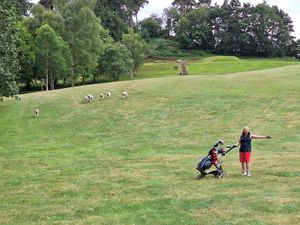Cliff railway's double celebration
One of Bridgnorth's most famous landmarks has been holding a double celebration to mark its birthday and new extension. One of Bridgnorth's most famous landmarks has been holding a double celebration to mark its birthday and new extension. Workers at The Cliff Railway, which has been transporting people between Low Town and High Town since 1892, have been celebrating the line's 116th birthday. Yesterday's anniversary was also marked with the official opening of a new two-storey extension and the addition of a finial to the roof of the Top Station. Steeplejacks from Elcock & Wood added the three-foot-high ornamental flourish, which matches the one already in place on the original railway building. Read the full story in today's Shropshire Star.
 One of Bridgnorth's most famous landmarks has been holding a double celebration to mark its birthday and new extension.
One of Bridgnorth's most famous landmarks has been holding a double celebration to mark its birthday and new extension.
Workers at The Cliff Railway, which has been transporting people between Low Town and High Town since 1892, have been celebrating the line's 116th birthday.
Yesterday's anniversary was also marked with the official opening of a new two-storey extension and the addition of a finial to the roof of the Top Station.
Steeplejacks from Elcock & Wood added the three-foot-high ornamental flourish, which matches the one already in place on the original railway building.
The extension, which was designed by Bridgnorth-based architect David Durham, houses a larger tearoom, which opened to visitors last year, a new office space and improved access to the engine room.
The railway was designed by Birmingham engineer George Croydon Marks who also built similar lines in Lynton and Lynmouth, Bristol, Aberystwyth and Scarborough.
It was opened at noon on July 7, 1892, by the town's mayor at a ceremony attended by the Willenhall Brass Band, residents and civic dignitaries.
It has been in virtually continuous use ever since then and has only been out of service for a short period between April 1933 and May 1934.
Originally water-powered, the hydraulic operation was abandoned in 1944 when the railway was converted to electrically driven winding.
The railway was bought in 1996 by Allan and Jean Reynolds.
They saw it for sale in a newspaper.
Jean, a retired lecturer, said they purchased it because the couple needed "something to do in our retirement".
"We both wanted to take early retirement from our jobs and wanted a hobby to keep us busy," she said.
"It was rather run down when we took over and there was an awful lot to do and today marks the completion of 10 years of hard work," she added.
"It's been a labour of love and it's taken over our lives rather, but it's been worth it to restore this wonderful building back to its former glory."
By Jonathan Wood





